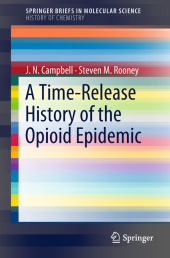 Neuerscheinungen 2018Stand: 2020-02-01 |
Schnellsuche
ISBN/Stichwort/Autor
|
Herderstraße 10
10625 Berlin
Tel.: 030 315 714 16
Fax 030 315 714 14
info@buchspektrum.de |

J. N. Campbell, Steven M. Rooney
(Beteiligte)
A Time-Release History of the Opioid Epidemic
1st ed. 2018. 2018. xviii, 134 S. 23 SW-Abb., 17 Farbabb., 40 Farbtabellen. 235 mm
Verlag/Jahr: SPRINGER, BERLIN; SPRINGER INTERNATIONAL PUBLISHING 2018
ISBN: 3-319-91787-0 (3319917870)
Neue ISBN: 978-3-319-91787-0 (9783319917870)
Preis und Lieferzeit: Bitte klicken
This Brief takes the reader on a chemical journey by following the history for over two centuries of how an opiate became an opioid, thus spawning an empire and a series of crises. These imperfect resemblances of alkaloids are both natural and synthetic substances that, particularly in America, are continually part of a growing concern about overuse. This seemed an inviting prospect for those in pain, but as the ubiquitous media coverage continues to lay bare, the levels of abuse point to the fact that perhaps an epidemic is upon us, if not a culture war.
Seeking answers to how and why this addiction crisis transpired over two hundred years of long development, this Brief examines the role that the chemistry laboratory played in turning patients into consumers. By utilizing a host of diverse sources, this Brief seeks to trace the design and the production of opioids and their antecedents over the past two centuries. From the isolation and development of the first alkaloids with morphine that relieved pain within the home and on the battlefield, to the widespread use of nostrums and the addiction crisis that ensued, to the dissemination of drugs by what became known as Big Pharma after the World Wars; and finally, to competition from home-made pharmaceuticals, the progenitor was always, in some form, a type of chemistry lab. At times, the laboratory pressed science to think deeply about society´s maladies, such as curing disease and alleviating pain, in order to look for new opportunities in the name of progress.
Despite the best intentions opioids have created a paradox of pain as they were manipulated by creating relief with synthetic precision and influencing a dystopian vision. Thus, influence came in many forms, from governments, from the medical community, and from the entrepreneurial aspirations of the general populace. For better, but mostly for worse, all played a role in changing forever the trajectory of what started with the isolation of a compound in Germany. Combining chemistry and history in a rousing new long-form narrative that even broadens the definition of a laboratory, the origins and future of this complicated topic are carefully examined.
Introduction: Chemical Heterotopias.- Part One: Alkaloid Heterotopias.- Part Two: Synthetic Opiate Heterotopias.- Epilogue: Opioid Heterotopias.
"The book aims to reconstruct the whole history of opioids isolated in the early 19th century on the basis of the traditional uses of poppy for pain relief. ... This book should be in all libraries, medical, public, or other, so it can be read by as wide an audience as possible. ... . a simple, clear, fluid style that results in a pleasant read. It is informative and debunks the myth about opioids and their simple rejection ... ." (Alain Touwaide, Doody´s Book Reviews, September, 2018)


